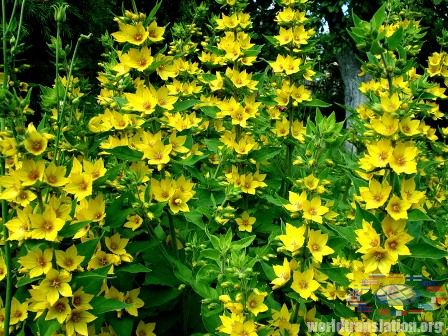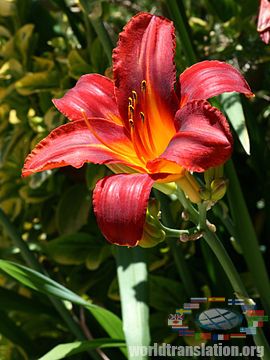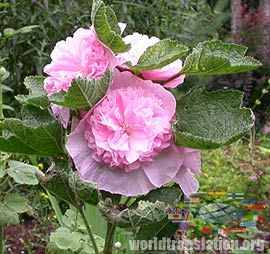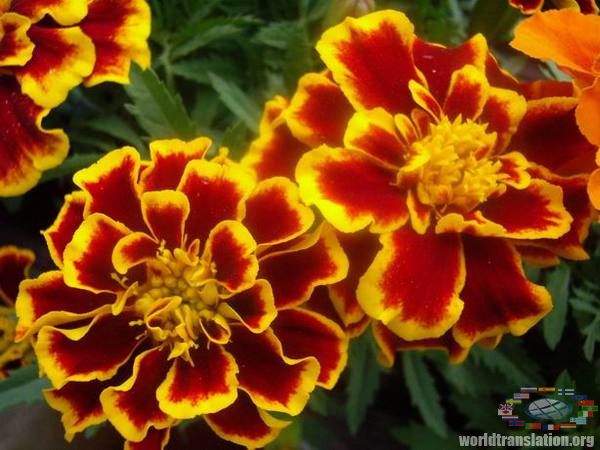Medicinal flowers

It is not a secret that people began to use the healing power of plants long time ago. But not everybody knows, that the flowers in our garden, which make us happy with their beauty can cure. Almost all the flowers have medicinal properties. It is only important to know these properties and use them correctly. However, we must remember that it is best not to fertilize the flowers intended for therapeutic purposes, because it can lead to a change in the balance of plant's medicinal substances and its medicinal properties. Organic fertilizers contain disease-causing bacteria, Giardia and worms cysts. It's better to use leaf mold for mulching in spring and autumn. Dotted loosestrife or Lysimachus, pleases us with its bright yellow flowers, which bloom in June.
Dotted loosestrife or Lysimachus, pleases us with its bright yellow flowers, which bloom in June.
- The juice from the fresh squeezed herb, strained through cheesecloth is used in nasal bleeding by digging a few drops in the nose. And when you have cuts: apply the crushed leaves to stop bleeding.
- A poultice of herb is used when there is the pain in the joints of rheumatoid origin, bruises, flu, tumors.
- If you have diarrhea or general weakness, then you need to use tincture of herb (1 tablespoon per 25 ml of boiling water, infuse 2 hours, after that filter) for 2 tablespoons 3-4 times a day. For thrush, stomatitis, the infusion is used for rinsing.
Dotted loosestrife has choleretic, astringent, tonic, antiseptic, anti-inflammatory, analgesic, wound healing and hemostatic effects. Grass and juice are harvested during flowering. Day-lily is a joy to the heart. Until recently, on the suburban areas and in front gardens people grew two types of day-lilies (small and brown-yellow), both with bright orange flowers. But recently the flow of different types of plants with white, purple, lilac, magenta colors, flowers of different colors and sizes rushed from abroad.
Day-lily is a joy to the heart. Until recently, on the suburban areas and in front gardens people grew two types of day-lilies (small and brown-yellow), both with bright orange flowers. But recently the flow of different types of plants with white, purple, lilac, magenta colors, flowers of different colors and sizes rushed from abroad.
They do not possess medicinal properties: in traditional medicine using only the flowers and herb of the usual orange day-lilies. They have antibacterial, hemostatic, wound healing, analgesic, anti-cancer actions.
Young shoots are rich in carotene and ascorbic acid, are also very pleasant to the taste, so they are used in salads, soups. And the buds of plant - are real delicacy, they are eaten in raw, salted and pickled forms.
For therapeutic purposes, the grass should be prepared during the flowering (leaves, flowers, stems), and rhizomes with roots - in the spring and autumn, of such sorts, as: Small day-lily and Thunberg.
- If you have weakened heart function, loss of strength, or after a long illness, angina, then take 10 orange flowers and pour them with a glass of boiling water, then filter. Drink 50 ml of infusion three times daily before meals.
- If you have hepatitis: Pour 2 tablespoons finely chopped herb with 0.5 liters of boiling water, then 3-5 minutes hold on fire. Leave for one hour, filter and take, usually before meals for 1/4 cup 2 times a day.
- Fill 1 tbsp. of dry material with 500 ml of boiling water, let it infuse for 2 hours, after that filter. Take it during fever, tumors, bleeding from the nose, as a tonic, 4 times a day for 120 ml with 1 tbsp. of honey.
- If you have rheumatism: Pour 2 tablespoons of flowers and leaves of day-lily with 0.5 liters of boiling water, then leave it for 2 hours in a thermos, let it infuse, then filter and take before eating for 2 tablespoons 2-3 times a day. Already in June starts the blooming of the rose mallow - one of the most beautiful garden plants. Mallow in its action can replace the flowers and roots of marsh mallow, providing a coating, anti-inflammatory actions, dilutes the thick mucus.
Already in June starts the blooming of the rose mallow - one of the most beautiful garden plants. Mallow in its action can replace the flowers and roots of marsh mallow, providing a coating, anti-inflammatory actions, dilutes the thick mucus.
- Pour 3 tsp. of chopped fresh petals with 1.5 cups of boiling water, then let it infuse for 2 hours in a sealed container, after that you need to filter it. Take warm tincture when you have cough (bronchitis, pneumonia) 2-3 times a day for 1/2 cup.
- If you have cystitis: Pour 2 tablespoons of already chopped fresh leaves and flowers with 0.5 liters of boiling water, then hold on low fire for 5 minutes, then infuse 1 hour in thermos, then filter. Then drink the warm infusion before eating, two times a day for 1/2 cup.
- If you have hemorrhoids: Pour 1 tablespoon of chopped leaves with 1/2 cup of boiling water, then infuse 1 hour, do not filter, and then make embrocations for 1.5 hours, soaking the gauze in the infusion. Is also used for burns.
- For a long time healing ulcers: dried petals of mallow chopped into powder, mix with boiled olive oil (1:1 ratio), soak a gauze and do bandage on the sore spot, try to change the bandage, 2 times a day. Tagetes have already met us at the gate and escort us to the porch. Among the people they are more commonly called velvets for their soft like a velvet petals. In China, the fresh flowers are added to salads and second dishes, and in Georgia powdered dried flower baskets are used as a spice (the Georgian saffron). Tagetes flowers are used as a diuretic, vitamins, antibacterial remedies.
Tagetes have already met us at the gate and escort us to the porch. Among the people they are more commonly called velvets for their soft like a velvet petals. In China, the fresh flowers are added to salads and second dishes, and in Georgia powdered dried flower baskets are used as a spice (the Georgian saffron). Tagetes flowers are used as a diuretic, vitamins, antibacterial remedies.
- If you caught a cold: pour 8-10 flower heads with 1 liter of boiling water, then hold it on fire for 5 minutes, infuse for 1 hour. Take, as a rule, before meals 2-3 times a day for 1/2.
- If you have deterioration of vision, the first sign of "night blindness", then add 2-3 small tagetes heads to soups and salads. The treatment can last up to one month.
- If you have miliaria (prickly heat), or skin irritation: pour 1 tablespoon of chopped tagetes flowers with 1 cup of boiling water, then hold it on fire for 5 minutes, infuse for 1 hour, press the materials, and wash problem areas with a broth 1-2 times a day.
- If you have a headache rip off the inflorescences at full blossom, drying and stuffing pillow, which is placed under the head for the night. Pain is leaving quietly.